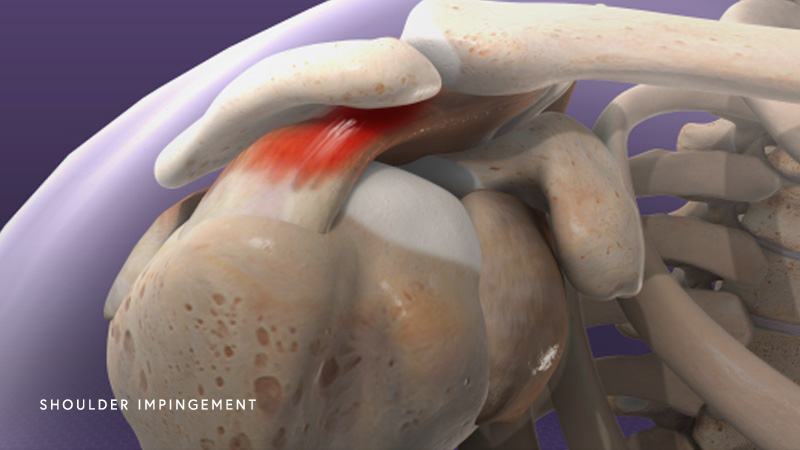Shoulder Impingement
Shoulder impingement is a very common cause of shoulder pain. This impingement occurs when there is abnormal contact and grinding of the bones that make up the shoulder joint. This increased friction can lead to cartilage deterioration and damage to the bones of the shoulder joint.
The shoulder is composed of the head (ball) of the humerus (upper arm bone) and the socket of the scapula (shoulder blade). There are two joints in the shoulder: the glenohumeral joint and the acromioclavicular joint. The glenohumeral joint is the ball-and-socket joint that is formed with the union of the head of the humerus and the socket of the scapula. The acromioclavicular joint is the junction of the clavicle (collarbone) with the scapula. Both joints are susceptible to impingement, which is why maximizing their strength and normal functionality is imperative.
The rotator cuff of the shoulder is composed of a group of muscles and tendons that surround the glenohumeral joint. The rotator cuff is made up of four muscles that all end in short, flat, and wide tendons which unionize with the fibrous capsule in order to form the musculotendinous cuff. This fusion occurs anywhere from ½ to ¾ of an inch from the point of insertion of the tendons into the humerus. The muscles of the rotator cuff include the Subscapularis Muscle, Infraspinatus Muscle, Teres Minor Muscle, and the Supraspinatus Muscle.
Shoulder Impingement is the result of repetitive rubbing of the rotator cuff between the humerus and bursa. This rubbing can lead to swelling and narrowing of the space between the humerus, bursa, and the acromion of the clavicle. Pain and irritation is common with shoulder impingement.

Shoulder impingement is caused by irritation or injury to the rotator cuff. The rotator cuff then begins to swell and become inflamed. Yet, because the rotator cuff is surrounded by bone, swelling reduces the amount of space between the rotator cuff and acromion. This leads to the rubbing and grinding of the cuff against the acromion. This grinding and rubbing of the muscles and tendons of the rotator cuff results in swelling and inflammation, which further reduces the space between it and the acromion like a vicious cycle. Bone spurs on the acromion can contribute to shoulder impingement by causing the space between the rotator cuff and acromion to become even more narrow.
There are many symptoms of shoulder impingement syndrome as it is contingent on many factors. Symptoms usually develop gradually over the course of a few weeks to a few months. These symptoms include:
- Pain when arms are raised above the head
- Pain when lifting the arm
- Pain when lowering the arm
- Pain when reaching
- Pain in the front of the shoulder
- Tenderness in the front of the shoulder
- Pain in the side of the arm
- Aching
- Inability to sleep due to shoulder pain
- Pain when reaching behind the back
- Stiffness
- Weakness
- Swelling
Symptoms of shoulder impingement are very similar to other conditions such as bursitis and tendonitis of the rotator cuff. Shoulder impingement can occur in tandem with these conditions.
During the physical exam, the physician will test the affected area for tenderness, swelling, and pain. The physician will also test the range of motion in the shoulder and ask if there is any pain or stiffness associated with the movement. Decreased range of motion is a major symptom of shoulder impingement. If the physician cannot diagnose shoulder impingement based on the results of a physical exam, then imaging is ordered to determine whether or not shoulder impingement is the main cause of the patient’s symptoms. XRays, CT (CAT) scans, and MRIs are often used to determine what is causing the symptoms. These imaging tests will reveal the positioning of the bones in the shoulder joint and whether or not the distance between the rotator cuff and acromion has narrowed.
The most common treatment for shoulder impingement is the R.I.C.E. method. The R.I.C.E. method has been known to decrease swelling, pain, and tenderness all while restoring shoulder function and overall range of motion. The R.I.C.E. method includes rest and immobilization, icing for 20 minutes every two hours, compression of the affected area, and elevation of the affected area. Medications are often used in conjunction with this method to reduce swelling, pain, and inflammation. Physical therapy is another course of action in tandem with the aforementioned methods in order to restore range of motion and strengthen the muscles of the rotator cuff while avoiding motions that irritate the condition.
If nonsurgical methods do not decrease symptoms, then there are a few surgical procedures that are recommended to resolve shoulder impingement. The most common procedure is arthroscopic shoulder decompression. This procedure involves an incision in the shoulder where a small camera and surgical tools are placed within the shoulder to remove part of the acromion and create more space for the rotator cuff. Open surgery, which involves a larger incision, is another surgical option to alleviate shoulder impingement.
If you or a loved one are currently experiencing any symptoms of shoulder impingement, or have been diagnosed and require treatment, reach out to the experts at the Center for Orthopaedic Specialists. Contact us today!




 / 50 Reviews
/ 50 Reviews